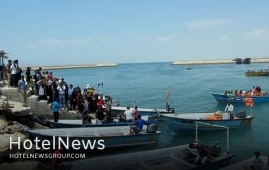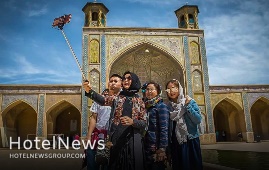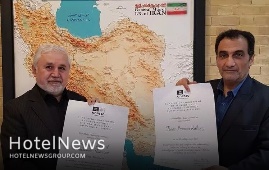
Iranian hotels are ready to receive foreign tourists as the issuance of tourist visas and the flow of foreign tourists from land and air borders will be resumed this month. Ninety percent of the hotel staff have been vaccinated against the coronavirus so far, so the hotels are ready to welcome foreign tourists, observing strict health protocols, the head of the Association of Iranian Hoteliers has announced. To ease the travel process, individual foreign tourists could confirm the reservations of accommodation centers at the border, CHTN quoted Jamshid Hamzehzadeh as saying on Monday. The destinations of foreign tourists in Iran are to specific cities such as Mashhad, Qom, Tabriz, Shiraz, Yazd, and Isfahan, and to return to the figure of over eight million incoming tourists before the outbreak of the coronavirus, serious planning is required, the official added. Iraqi tourists will flood the country once the borders open, but attracting tourists from Europe will require some time, he noted. Foreign advertising in foreign media and press, on the internet, and through well-known international bloggers should also be planned and taken seriously, he mentioned. Earlier this month, the official noted that Iranian hotels have lost 202 trillion rials (some $4.8 billion at the official exchange rate of 42,000 rials per dollar) of potential revenues due to the COVID-19 pandemic. Two-thirds of the hotel staff have lost their jobs as well, he added. Back in September, Hamzehzadeh announced that all employees of accommodation centers across Iran are scheduled to be vaccinated against the coronavirus. “To vaccinate staffs of all accommodation centers, including eco-lodges, apartment hotels, and guest houses, as well as hotels, more coordination with the Ministry of Health is needed,” he added. Back in July, ISNA reported that the tourism industry of the country has suffered a loss of some 320 trillion rials ($7.6 billion at the official exchange rate of 42,000 rials per dollar) since the outbreak of the coronavirus pandemic. The pandemic has also ruined more than 44,000 jobs in a once budding travel sector of the country, the report added. Experts believe accommodation centers suffered the most as a result of the outbreak of the coronavirus in Iran and its subsequent unemployment and financial losses. Iran plans to resume issuing tourist visas Back in September, Cultural Heritage, Tourism and Handicrafts Minister Ezzatollah Zarghami announced that by the order of President Ebrahim Raisi the issuance of tourist visas and the flow of foreign tourists from land and air borders will be resumed from the month of Aban (Oct. 23 – Nov. 21) following 19 months of suspension. Months of steep recession has taken its toll. Many travel insiders, hoteliers, and tour operators have faced big dilemmas such as bankruptcy, unemployment, debts, and the prospects of not being competitive on the international level. They now have good grounds of hope as Zarghami announced on September 19 that the country plans to lift visa restrictions to help the severely hit tourism industry. Meanwhile, the number of people testing positive for COVID-19 has continued to fall in the Islamic Republic, curbing a stubborn fifth wave of the pandemic, which has seen daily mortalities of up to 700 in recent weeks. As of September 22, the figure dropped to below 300 as the government has devoted a great deal of effort to vaccinate citizens against the nasty virus. Some experts believe Iran is still somehow “unknown” for many potential travelers due to Western “media war”. Several estimates have been released so far on the extent of the tourism-related losses incurred by the pandemic. Only months into the outbreak, Zarghami’s predecessor, Ali Asghar Mounesan, lamented that the number of foreign travelers to Iran was drastically plunged due to the pandemic. “Tourism of the country was growing before the corona [outbreak], its revenues reached $11.7 billion in 2019, which accounted for 2.8% of GDP, nearing the average share of tourism in the world GDP, which was 3.2 percent,” Mounesan said. He added 8.7 million foreign nationals visited Iran during the [Iranian] year (1398), adding that Iran was ranked as the second fastest-growing country in tourism based on data compiled by the World Tourism Organization. Iran is potentially a booming destination for travelers seeking cultural attractions, breathtaking sceneries, and numerous UNESCO-registered sites. Under the 2025 Tourism Vision Plan, Iran aims to increase the number of tourist arrivals from 4.8 million in 2014 to 20 million in 2025.
Create: Oct 18, 2021 Edit: Oct 19, 2021 Regional News
The World Travel & Tourism Council (WTTC) says the UK’s Travel & Tourism sector’s year on year recovery may only claw back a third, whilst international travel spending continues to plummet. Latest research from WTTC, which represents the global Travel & Tourism sector, shows the recovery has been severely delayed by the lack of spending from international visitors. WTTC blames strict travel restrictions, such as the destructive ‘traffic light’ system, for wreaking havoc on the sector. Now, despite its highly successful vaccine rollout, the UK is set to record further losses in inbound visitor spending than the previous year, a year in which international travel ground to an almost complete standstill. At the current rate of recovery, WTTC research shows the UK’s Travel & Tourism sector’s contribution to the nation’s economy could rise year on year by just under a third (32%) in 2021, broadly in line with the global average of 30.7%. However, research conducted by the global tourism body shows the increase has been primarily spurred on by the recent boom in domestic travel, with domestic spending growth set to experience a year on year rise of 49% in 2021. While this surge in domestic travel has provided a much-needed boost, it will not be enough to achieve a full economic recovery and save millions of jobs still under threat. The research goes on to show that international spending is predicted to plunge by nearly 50% on 2020 figures – one of the worst years on record for the Travel & Tourism sector – making it one of the worst performing countries in the world. While other countries, such as China and the U.S., are set to see a rise in international travel spending this year, the UK lags and continues to record significant losses. Severe travel restrictions, ever-changing policies, and barriers to travel to the UK, such as the current requirement for visitors to take an expensive day two PCR test after arriving in the country, have had their toll. Last year, the UK Travel & Tourism sector saw 307,000 job losses across the country and research shows that jobs in the sector are set to remain flat this year. Julia Simpson, WTTC President & CEO said: “WTTC research shows that while the global Travel & Tourism sector is beginning to recover, the UK continues to suffer big losses due to continuing travel restrictions that are tougher than the rest of Europe. Looking ahead to 2022, WTTC research provides grounds for optimism. With the right measures and a strong focus on international travel, the UK could see Travel & Tourism’s contribution to GDP rise by 53% in 2022, resulting in an additional £66 billion to its economy. International visitor spending could also see a significant increase reaching £29 billion – just 20% below 2019 levels. Meanwhile, employment growth could see a 14% boost year on year, equating to additional 580,000 jobs in 2022, resulting in over 4.7 million jobs, which is 445,000 above 2019 levels.
Create: Oct 16, 2021 Edit: Oct 16, 2021 International News
Bushehr province should invest a great deal of effort to develop its maritime tourism, the deputy tourism minister Ali-Asghar Shalbafian has said. TEHRAN - Busher province should invest a great deal of effort to develop its maritime tourism, the deputy tourism minister Ali-Asghar Shalbafian has said. “If the southwestern Bushehr province wants to develop tourism, it should focus on maritime sector,” the official said on Thursday. “The province needs to inform investors about its capacity in this sector, especially its favorable location on the Persian Gulf coast.” He made the remarks during a meeting with the provincial tourism chief Mohammad Hossein Arastuzadeh. The coastal region, ports, islands and coasts of the Persian Gulf are among Bushehr's greatest natural gifts, therefore, directing the investment capacities and enthusiastic investors to the maritime tourism sector will facilitate the growth of Bushehr as a coastal tourist destination, Shalbafian explained. For his part Arastuzadeh said that by using cruise ships and traditional Lenj boats in the region, maritime tourism has grown. Over the past couple of years, the Islamic Republic has made various efforts to exploit maritime tourism potential by developing hospitality infrastructures, diversifying sea routes, and drawing private sector investors along its vast southern coasts. Prosperous maritime tourism could help the county to meet its ambitious target of attracting 20 million annual tourists by 2025. It also keeps an eye on tourism developments in the Caspian Sea in the north. Back in February, the Ministry of Tourism and the Ministry of Transport and Urban Development signed a memorandum of understanding (MOU) to develop maritime tourism and make the best use of its potential in the southern and northern coasts of the country. Promoting the culture of using the sea as a tool to increase social vitality, development of coastal activities in the form of environmentally-friendly plans and programs, and creating the necessary grounds for cooperation and exchange of knowledge and information were also among the topics of the agreement. With over 6,000 years of history and significant monuments from the Elamite, Achaemenid, Parthian, and Sassanid eras, Bushehr is one of Iran’s most important historical centers. Besides its cultural heritage, beautiful beaches and lush palm groves make it an attractive destination for world travelers. The historical and architectural monuments of Bushehr include Islamic buildings like mosques and praying centers, mansions, old towers, castles, as well as gardens. When it comes to cultural attractions, there are many historical mounds in Bushehr including Tall-e Khandaq with Sassanid architectural style, Tall-e Marv located near an Achaemenid Palace, and Qajar era Malek al-Tojar Mansion. Qajar era Kazeruni Mansion, which has been inscribed on the World Heritage List, is another attraction that world travelers love to see among various ancient sites.
Create: Oct 16, 2021 Edit: Oct 16, 2021 Regional News
Recent weather disasters, social unrest and a heightened awareness of racial bias have prompted hoteliers to double down on their commitments to become better corporate citizens and do more to address environmental, social and governance (ESG) issues. These are moves toward a social good, sure, but also have ramifications on hotel company P&Ls. Marriott International, for one. It recently announced a commitment to reach net-zero emissions of greenhouse gases by 2050. The pledge follows the previous setting of goals by the massive global company to reduce single-use plastics, cut down on food waste by 50% and significantly amp up the diversity of suppliers, among other measures. InterContinental Hotels Group is another. Earlier this year it announced plans “to make a positive difference for our people, communities and planet over the next decade.” The company’s new commitments include a 15% “absolute reduction” of energy use and carbon emissions; a reduction of waste that will include the elimination of single-use items and a “prevent, donate, divert” plan for food waste; increased water conservation efforts; new programs to “improve the lives of 30 million people in our communities around the world” and, for employees, to “champion a diverse culture where everyone can thrive.” All of these measures benefit the public good and also have impact on a hotel’s ability to control expenses, particularly in regard to energy management. “Saving energy can—and will—impact profitability,” said Denise Naguib, VP of Sustainability and Supplier Diversity at Marriott. “For many properties, the second largest cost after labor is energy, and in some markets it actually supersedes labor, so this is a real cost that impacts the bottom line.” Energy By The Numbers Energy costs are mainly variable and there are ways to control this expense, which is of the moment now as the expense creeps back up. In U.S. hotels, the cost of electricity jumped to $4.31 in August on a per-available-room basis, compared to $3.35 in July 2020, according to HotStats data. Year-to-date August, hotels were paying $3.32 for energy, compared to $2.94 over the same period a year prior. Europe saw a similar rise, with August electricity at €6.26 compared to €8.26 in the same month last year, and €8.67 in the first eight months of this year compared to €8.26 in the same period a year ago. Small Steps, Big Rewards Operational changes large and small can help drive energy efficiency. “One of our hotels that had a high energy bill brought on an energy manager,” Naguib said. “That person found energy efficiencies and reduced the property’s energy bill by $1 million.” On a broader level, she added, properties need to empower engineers and others to find energy efficiencies, such as shutting a foyer light that’s kept on all day, deploying technology to regulate temperatures and electric usage throughout the space. Smart uses of food, such as saving the ends of vegetables for stews or making more scrambled eggs at the start of breakfast to avoid whipping up too many at the end of service, can have an impact. Energy purchasing decisions and the education of employees also can make a difference. That hands-on approach also can be used when working to make hoteliers’ purchasing choices more inclusive, Naguib said. “If any of our associates are working on RFPs or RFIs, we help them seek out diverse suppliers, such as women or minority-owned businesses. It adds more voices to the table for bidding opportunities.” Such shifts generate customer loyalty, IHG noted when it announced the company’s enhanced ESG policies.
Create: Oct 13, 2021 Edit: Oct 13, 2021 Hotel Management
A total of 2007 beds is expected to be added to the hospitality sector of West Azarbaijan province, the provincial tourism chief has said. Currently, 41 tourism-related projects including hotels, apartment hotels, eco-lodges, and tourist complexes are underway across the northwestern province, Jalil Jabbari announced on Sunday. The province will increase its accommodation capacity by 974 rooms and 2007 beds through the opening of the mentioned ongoing projects, the official added. So far, the projects have progressed by 42 percent, he noted. Back in April, the official announced that tourism-related projects generated 1,767 job opportunities across the province during the past Iranian calendar year 1399 (ends March 21). “The largest number of jobs is related to the issuance of licenses for handicraft producers, which has led to the employment of 549 persons,” he noted. Iran considers reopening borders to foreign vacationers as its new tourism minister has said the government will soon scrap visa restrictions. Though international tourism has revealed signs of a rebound as some destinations eased travel restrictions over the past couple of months, the lack of international coordination and slow vaccination rates in several countries and regions suggest it may need a longer time to bounce back. On the one hand, according to the latest edition of the UNWTO World Tourism Barometer, an estimated 54 million tourists crossed international borders in July 2021, down 67% from the same month in 2019, but the strongest results since April 2020. This compares to an estimated 34 million international arrivals recorded in July 2020, though well below the 164 million figure recorded in 2019. On the other hand, another research conducted by Oxford Economics on behalf of the World Travel and Tourism Council (WTTC) reveals that countries’ GDP is expected to increase only by less than one-third, as tourism is recovering even slower than expected. The research was based on the current vaccination rates globally, consumer confidence, and less stringent entry and travel restrictions in the world. However, prospects for September-December 2021 remain mixed, according to the latest UNWTO Panel of Experts survey, with 53% of respondents believing the period will be worse than expected. Only 31% of experts expect the point to better results towards the end of the year. The survey also shows that most tourism professionals continue to expect a rebound driven by unleashed pent-up demand for international travel in 2022, mostly during the second and third quarters. West Azarbaijan embraces a variety of lush natural sceneries, cultural heritage sites, and museums including the UNESCO sites of Takht-e Soleyman and Qareh Klise (St. Thaddeus Monastery), Teppe Hasanlu, and the ruined Bastam Citadel. The region was home to several ancient civilizations. According to Britannica, it was conquered by Alexander the Great in the 4th century BC and was named Atropatene after one of Alexander’s generals, Atropates, who established a small kingdom there. Ultimately, the area returned to the Persian (Iranian) rule under the Sasanians in the 3rd century CE.
Create: Oct 13, 2021 Edit: Oct 13, 2021 Regional News
Though international tourism has revealed signs of a rebound as some destinations eased travel restrictions over the past couple of months, the lack of international coordination and slow vaccination rates in several countries and regions suggest it may need a longer time to bounce back. On the one hand, according to the latest edition of the UNWTO World Tourism Barometer, an estimated 54 million tourists crossed international borders in July 2021, down 67% from the same month in 2019, but the strongest results since April 2020. This compares to an estimated 34 million international arrivals recorded in July 2020, though well below the 164 million figure recorded in 2019. On the other hand, another research conducted by Oxford Economics on behalf of the World Travel and Tourism Council (WTTC) reveals that countries’ GDP is expected to increase only by less than one-third, as tourism is recovering even slower than expected. The research was based on the current vaccination rates globally, consumer confidence, and less stringent entry and travel restrictions in the world. However, prospects for September-December 2021 remain mixed, according to the latest UNWTO Panel of Experts survey, with 53% of respondents believing the period will be worse than expected. Only 31% of experts expect the point to better results towards the end of the year. The survey also shows that most tourism professionals continue to expect a rebound driven by unleashed pent-up demand for international travel in 2022, mostly during the second and third quarters. Almost half of all experts (45%) continue to see international tourism returning to 2019 levels in 2024 or later, while 43% point to a recovery in 2023. By regions, the largest share of experts pointing to a return to 2019 levels in 2024 or later are in Asia and the Pacific (58%). In Europe, half of the respondents indicate this could happen in 2023. West Asia is the most optimistic, with a full recovery expected by 2022. The sector needs leaders who can recognize ideas that will make a difference, who will innovate and back entrepreneurs and start-ups. As mentioned by the UNWTO Barometer, most destinations reporting data for June and July 2021 saw a moderate rebound in international arrivals compared to 2020. Nevertheless, 2021 continues to be a challenging year for global tourism, with international arrivals down 80% in January-July compared to 2019. Asia and the Pacific continued to suffer the weakest results in the period January to July, with a 95% drop in international arrivals compared to 2019. West Asia (-82%) recorded the second-largest decline, followed by Europe and Africa (both -77%). The Americas (-68%) saw a comparatively smaller decrease, with the Caribbean showing the best performance among world subregions. Meanwhile, some small islands in the Caribbean, Africa, and Asia and the Pacific, together with a few small European destinations recorded the best performance in June and July, with arrivals close to, or sometimes exceeding pre-pandemic levels.” Iran preparing for tourism rebound Iran considers reopening borders to foreign vacationers as its new tourism minister has said the government will soon scrap visa restrictions. Cultural Heritage, Tourism and Handicrafts Minister Ezzatollah Zarghami made the announcement last month following his conversations with President Seyyed Ebrahim Raisi, however, the minister did not specify the date upon which those regulations would be scrapped. According to some sources, fully vaccinated travelers would be embraced first under the updated regulations. The average of international travels to and from the Islamic Republic fell by 80 percent during the past Iranian calendar year 1399 (ended on March 20, 2021) from a year earlier. “During this period, 4,343,163 passengers entered the country, which included 3,030,464 Iranian passengers and 512,699 international travelers,” according to Arezou Ghaniun, an official with the Islamic Republic of Iran's Customs Administration. “From the beginning of 1399 to the end of it, we saw a significant reduction in passenger traffic to the country or vice versa in land, sea, rail and air borders, which were caused by various coronavirus restrictions.” Months of steep recession has taken its toll. Many travel insiders, hoteliers, and tour operators have faced big dilemmas such as bankruptcy, unemployment, debts, and the prospects of not being competitive on the international level. Panels of travel experts have mapped out new marketing strategies hoping Iran’s tourism would get back on its feet once again. For instance, the Head of the Iranian Tour Operators Association has said the international tourist flow to Iran will return to normal until 2022. Iran is potentially a booming destination for travelers seeking cultural attractions, breathtaking sceneries, and numerous UNESCO-registered sites. Under the 2025 Tourism Vision Plan, Iran aims to increase the number of tourist arrivals from 4.8 million in 2014 to 20 million in 2025. Domestic tourism as a propeller in COVID era The annual UNWTO Executive Training Programme, which was held in the Maldives from October 5 to 8, sharpened the focus on harnessing the power of domestic tourism to drive recovery and growth in destinations across Asia and the Pacific. Now in its 15th year, the event brought together representatives of 25 countries, with six (Iran, Sri Lanka, Afghanistan, Bangladesh, Mongolia, and Nepal) joining hosts in the Maldives to attend the training sessions in person. Reflecting the restart of domestic tourism ahead of international tourism, both across Asia and the Pacific and globally, the event focused on enabling destinations of all sizes to capitalize on this trend. Opening the event, UNWTO Secretary-General Zurab Pololikashvili stressed that, as tourism restarts in many parts of the world, “the sector needs leaders who can recognize ideas that will make a difference, who will innovate and back entrepreneurs and start-ups”. Confidence in travel rising sluggishly Such an enhancement was underpinned by the reopening of many destinations to international travel, mostly in Europe and the Americas. The relaxation of travel restrictions for vaccinated travelers, coupled with the progress made in the roll-out of COVID-19 vaccines, contributed to lifting consumer confidence and gradually restoring safe mobility in Europe and other parts of the world. In contrast, most destinations in Asia remain closed to non-essential travel. According to UNWTO Secretary-General Zurab Pololikashvili, there is a strong demand for international tourism, and many destinations have started welcoming visitors back safely and responsibly. However, the true restart of tourism and the benefits it brings remains on hold as inconsistent rules and regulations and uneven vaccination rates continue to affect confidence in travel,” Pololikashvili says.
Create: Oct 10, 2021 Edit: Oct 10, 2021 Regional News
Certificates of registration of four Iranian UNESCO World Heritage sites have been handed over to the tourism ministry, the deputy tourism minister has announced. The Ministry of Cultural Heritage, Tourism, and Handicrafts has received registration certificates of four cultural heritage, which have been listed by UNESCO over the last two years, IRNA quoted Ali Darabi as saying on Friday. The ministry has received certificates for Trans-Iranian Railway, Cultural Landscape of Uramanat as tangible cultural heritages as well as the art of miniature, jointly with Azerbaijan, Turkey, and Uzbekistan and pilgrimage to St. Thaddeus jointly with Armenia, as UNESCO Intangible Cultural Heritage, the official added. Having a global register of tangible and intangible heritage is vital because these works, regardless of race, nationality, and religion, belong to all human society, and all governments and nations have a duty to preserve and protect them, even during times of war, he noted. Increased recognition of a country’s cultural heritage on the World Heritage list certainly contributes to the development of the tourism industry and businesses related to it, and most importantly, introduces the culture and civilization of a nation to the world, he explained. With 26 World Heritage Sites, Iran ranks 10th in the world in terms of the number of historical monuments and sites registered on the UNESCO World Heritage list. Before the Islamic Revolution, Persepolis, Naghsh-e Jahan Square, and Choghaznabil were the only three UNESCO-listed monuments, but today the number has been increased this number to 26 historical sites. Trans-Iranian Railway The railway can be regarded as a turning point for comprehensive developments in Iran. These developments include a wide spectrum of various economical, commercial, social, cultural, and even political aspects in a sensitive and important period of contemporary world history. Consequently, the 1394 kilometers long Trans-Iranian Railway was built with a width of 1435mm and 90 working stations along its route. It starts at a point north of Torkaman port located southeast of the Caspian Sea. After going through Sari and Qaem-Shahr cities, the railway enters the mountainous region of Alborz through the high Firooz-kooh Pass which is linked with Tehran and Varamin Plain by numerous bridges and tunnels. Further on after crossing the flatlands of Qom and Arak, the Trans-Iranian Railway penetrates Zagros highlands in Lorestan Province and passing through a large number of tunnels and bridges reaches Andimeshk situated in the low Kuzestan Plain. Finally extending to the vicinity of Dezful, Ahwaz, and its grand bridge on Karoon, the Trans-Iranian Railway is divided into two branches ending separately at Khoram-Shahr and Imam-Khomeini ports on the Persian Gulf. Cultural Landscape of Uramanat Stretched on the slopes of Sarvabad county, and shared between the provinces of Kordestan and Kermanshah, the rural area of Uramanat embraces dense and step-like rows of houses in a way that the roof of each house forms the yard of the upper one, a feature that adds to its charm and attractiveness. As the cultural landscape covers 300 villages and in terms of architecture and landscape, it is one of the most beautiful and presentable heritages in the world. Uraman is considered a cradle of Kurdish art and culture from the days of yore. Pirshalyar, which is named after a legendary local figure, is amongst time-honored celebrations and rituals that are practiced annually across the region. The art of miniature The miniature is a type of two-dimensional artwork that involves the design and creation of small paintings on books, paper-mâché, rugs, textiles, walls, ceramics, and other items using raw materials such as gold, silver, and various organic substances. Historically, the miniature was exemplified by book painting in which the text was supported visually, but the element has evolved and can also be observed in architecture and as an adornment in public spaces. The miniature displays a specific type of perspective in which the size of the figures changes according to their importance - a key difference between realistic and naturalistic styles. Though it has existed for centuries, it continues to develop and thus strengthens the bonds between past and present. Traditional painting principles and techniques are preserved, but artists also bring individual creativity into the process. Pilgrimage to the St. Thaddeus The annual three-day pilgrimage to St. Thaddeus Apostle Monastery in northwestern Iran is held each July. The pilgrimage venerates two prominent saints: St. Thaddeus, one of the first apostles preaching Christianity, and St. Santukhd, the first female Christian martyr. The bearers of the element are the Armenian population in Iran, Iranian-Armenians residing in Armenia, and followers of the Armenian Apostolic Church. Pilgrims gather in Tabriz before departing for the monastery. They cover 700 kilometers from Yerevan to the monastery annually. The commemoration ceremony includes special liturgies, processions, prayers, and fasting. It culminates in a Holy Mass with Holy Communion. Special times are set aside for traditional Armenian folk performances and Armenian dishes are served. The pilgrimage is the primary social and cultural event of the year.
Create: Oct 10, 2021 Edit: Oct 10, 2021 Regional News
The Travel & Tourism sector’s continued sluggish recovery will see its year-on-year contribution to global GDP rise by less than one third in 2021, according to new research from the World Travel & Tourism Council (WTTC). WTTC, which represents the global Travel & Tourism private sector, says the recovery of the sector has been hampered by the lack of international coordination, severe travel restrictions and slower vaccination rates in some parts of the world which still hamper many regions of the world. In 2019, the Travel & Tourism sector generated nearly USD 9.2 trillion to the global economy, however in 2020, the pandemic brought Travel & Tourism to an almost complete standstill which resulted in a 49.1% drop, representing a punishing loss of nearly USD$ 4.5 trillion. While the global economy is set to receive a modest 30.7% year on year increase from Travel & Tourism in 2021, this will only represent USD 1.4 trillion and is mainly driven by domestic spending. The economic modelling was conducted by Oxford Economics on behalf of WTTC and calculated a baseline scenario based on the current global vaccination rollout, consumer confidence and relaxed travel restrictions in some in regions around the world. The research reveals that at the current rate of recovery, Travel & Tourism’s contribution to the global economy could see a similar moderate year on year rise of 31.7% in 2022. Last year, WTTC revealed the loss of a staggering 62 million Travel & Tourism jobs around the world and with the current pace of recovery, jobs are set to rise by only 0.7% this year. Similarly, research shows a more hopeful potential year-on-year jobs rise across the sector next year, by a positive 18%. Julia Simpson, WTTC President & CEO said: Our research clearly shows that while the global Travel & Tourism sector is beginning to recover from the ravages of COVID-19 there are still too many restrictions in place, an uneven vaccine rollout, resulting in a slower than expected recovery of just under a third this year. Last year, 62 million Travel & Tourism jobs were lost globally, and our data shows a rise of a meagre 0.7% this year. While next year is looking more positive in terms of the global economy and jobs, the current rate of recovery is simply not fast enough and is in the most part driven by domestic travel, which will not achieve a full economic recovery. If governments can start looking internationally and support Travel & Tourism with simplified rules to enable the safe return of travel, there is the opportunity to save jobs and boost economic wealth”. According to the research, the sector’s contribution to global GDP and the rise in jobs could be more positive this year and next, if the following measures are met: Allow fully vaccinated travellers to move freely, irrespective of their origin or eventual destination, removing complex tiered systems. The implementation of digital solutions which enable all travellers to easily prove their COVID status, so in turn speeding up the process at borders around the world. Recognition of all vaccines authorised by the World Health Organisation (WHO) and/or any of the Stringent Regulatory Authorities (SRA).Agreement from all relevant authorities that international travel is safe with enhanced health and safety protocols. The future could be brighter The research shows that if these four vital rules are followed before the end of 2021, the impact on the global economy and jobs could be significant. According to the data, the sector’s contribution to the global economy could jump by 37.5% – reaching USD 6.4 trillion this year (compared to USD 4.7 trillion in 2020). However, there is still hope if restrictions continue being lifted and with more international cooperation, governments could bring back nearly 19 million jobs before the year ends (up 6.8%). The trend continues into next year when the sector’s contribution to the global economy could see a year on year rise of 34%, reaching USD 8.6 trillion, close to 2019, a record year for Travel & Tourism. Similarly, jobs could surpass 2019 levels – up 20.1% year on year, to more than 349 million.
Create: Oct 9, 2021 Edit: Oct 9, 2021 International News
Residence Inn by Marriott, part of Marriott Bonvoy’s portfolio of 30 extraordinary brands, announced today the opening of its newest property, Residence Inn by Marriott Bogotá. Marking Residence Inn’s debut in Colombia, the hotel is located at Calle 90 # 16-30, just a few steps from 93rd Street Park and in the middle of the most vibrant and cosmopolitan area in the Colombian capital. Operated by oxoHotel — a company specialized in the conceptualization, development and operation of multi-brand and multi-segment accommodations — the new Residence Inn by Marriott Bogotá welcomes business and leisure travelers with upscale design and architecture that enhances the guest experience with open spaces to relax and live without constraints. Residence Inn by Marriott Bogotá provides direct access to Chicó Market (Mercado del Chicó), an innovative gastronomic complex with more than 30 gastronomic offerings, located adjacent to the hotel, as well as to Bodytech Calle 90, one of the best medical sports clubs in Colombia. “We are very pleased to introduce the Residence Inn by Marriott brand for the first time in Colombia,” said Diane Mayer, Vice President & Global Brand Manager of Classic Select Brands, Marriott International. “We’ve seen increased demand for longer stay brands that offer modern amenities, open room layouts and sophisticated design to spread out, recharge and maintain a healthy balance while on the road, whether for business or for fun. Travelers can make the most of their stay by choosing the Residence Inn by Marriott Bogotá.” The hotel offers 131 all-suite, flexible guest rooms including studios and one- or two-bedroom suites. Guests will feel right at home with separate areas for living and sleeping with plush bedding and linens, providing an intimate atmosphere that invites connection and productivity. The hotel design makes use of organic materials and textures combined with warm colors, transition palettes, as well as textiles and ancestral Colombian goldwork that feature crisp and inspiring details, offering comfort the moment a guest enters the hotel lobby. LONGER STAY Designed for stays of five nights or more with maximum benefits in mind, Residence Inn stands out for its modern residential decor based on the idea of ‘travel the way you live.’ It is a concept where openness, freedom and love for life translate into personalized service and unrestricted experiences. Fully equipped kitchens in each suite – complete with a refrigerator, cook top, microwave, dishwasher, residential-size appliances, and dishes and cookware – set the stage for home-cooked meals, paired with Residence Inn’s complimentary grocery delivery. Guests will also appreciate large in-suite workspaces with a well-lit desk, ergonomic seat and high-speed wireless internet access. Residence Inn offers a wide variety of healthy and natural options on rotation for its daily complimentary breakfast, included in the room rate. We are delighted to open the first Residence Inn in Colombia in an area surrounded by impressive shops, restaurants and experiences that invite business and tourism. Each suite has been developed to create sensations of being close to home with personalized welcoming moments,” said Juan Carlos Galindo, CEO of oxoHotel. “With this opening, we are not only reaffirming our intention to offer enhanced experiences to our guests, but also to reignite tourism and new hotel projects in Colombia.”
Create: Aug 1, 2021 Edit: Aug 1, 2021 International News
Stonebridge Companies, a privately owned, innovative hotel owner, operator and developer headquartered in Denver, has announced that The Slate Hotel at the site of the historic original Emily Griffith Opportunity School will begin welcoming guests this fall. Stonebridge Companies is the property owner and developer and will operate the hotel under the Tapestry Collection by Hilton brand. The 4-story, 135,000-square-foot property will add 251 guest rooms to downtown Denver, supporting the area’s strong demand for hospitality offerings. Located immediately adjacent to the Colorado Convention Center at 1250 Welton St., The Slate Hotel will assist the convention center in attracting additional events based on increased hotel room capacity. Hotel amenities include the use of digital keys, allowing guests to access their rooms via smartphone, complimentary Wi-Fi, a business center and state of the art A/V system to accommodate virtual, in-person and hybrid meetings, 4,370 square feet of meeting and event space, a signature bar and restaurant, lounge, outdoor patio and fitness center. Tapestry Collection by Hilton hotels offer distinctive guest experiences authentic to the destination, highlighting each hotel’s unique identity and story. Paying tribute to the campus’ legacy within Denver, the redevelopment of the 2.4-acre Denver landmark preserved the historic buildings that housed the former Emily Griffith Opportunity School and reactivated a downtown property that otherwise sat dormant. Denver has been home to Stonebridge Companies for 30 years, and since the project’s start, it’s been our privilege to play a role in honoring the legacy of the Emily Griffith Opportunity School and its vast impact on generations of Denver residents,” said Navin C. Dimond, founder, CEO and chairman of Stonebridge Companies. “We’re delighted to work with longtime partner Hilton to launch The Slate Hotel, revitalizing an important piece of our city’s history and offering Distinguished Hospitality™ to those visiting downtown Denver.” Stonebridge Companies purchased the former Emily Griffith Opportunity School property from Denver Public Schools in May 2017 and broke ground on the redevelopment in April 2019 after Denver City Council approved the property’s redevelopment plan in October 2018.
Create: Jun 20, 2021 Edit: Jun 20, 2021 International News
Iranian President Hassan Rouhani has urged sustainable efforts towards developing medical tourism across the country. “Health tourism is of great importance to us, and hospitals located in the border provinces of the country can serve a pivotal role in developing medical tourism by providing medical services to foreign guests and tourists,” Rouhani said on Thursday. He made the remarks on the sidelines of the inauguration ceremony of some health projects, urging the need for reinforcing medical and health services in some provinces, including Khorasan (Razavi), Isfahan, Fars, and East Azarbaijan, is an absolute duty. “For the time being, many Iranians living in foreign countries prefer to choose homeland for their treatment or certain surgeries,” he said, adding such a trend indicates great efforts made by “dear doctors and nurses and all the dear ones who work in the health sector”. Medical tourism is booming worldwide as about 20 to 24 million people are traveling for medical treatments annually. Factors such as increased care needs over longer lifespans, rising healthcare costs, and constant pressures on some insurance industries are reasons behind why some opt to travel abroad. Regarding price competitiveness, Iran currently ranks first in the world but the country has not been very successful in attracting potential travelers as other competitors like Singapore and Turkey. People from the Persian Gulf littoral states, Iraq and Syria as well as Iranian expatriates residing in Canada and Germany constituted the majority of medical travelers to the Islamic Republic, who received plastic, cosmetics, open-heart, and orthopedic surgeries amongst other treatments over the past couple of years. The Islamic Republic has set goals to exceed its yearly medical travelers to around two million in [calendar year] 1404 (March 2025-March 2026). Amongst Iran’s trump cards are the presence of credible surgeons and physicians, cutting-edge medical technologies, high-tech medicine and diverse specializations, super affordable procedures, and finally its hospitable people.
Create: Jun 19, 2021 Edit: Jun 19, 2021 Regional News
When are groups coming back? This is undoubtedly a question on many hoteliers’ minds, but perhaps the better question is, how are you going to manage operations when they do come back? Right now, the industry is narrowly focused on two central issues – the post-pandemic surge in leisure guests (as epitomized by the concept of ‘revenge travel’) and the labor shortages resulting from so many furloughed staffers permanently leaving the industry (amongst other factors). Both of these matters not only influence the groups segment, but also compound many of their underlying problems. To help navigate the impact of these two issues to realize big revenue gains from the upcoming return of groups, we recruited Steve Anevski, CEO and Co-Founder of Upshift (www.upshift.work), an on-demand staffing platform with the backing of Recruit Holidings (parent company of Indeed). The company has experienced tremendous growth in the past two quarters, particularly as Upshift’s ability to properly vet then deliver high quality shift workers gives hotels the assurance they need to effectively facilitate events once more Revenge Travel for Groups To the first of these concerns, the psychology of revenge travel, in combination with general stir-craziness and what’s dubbed ‘mortality salience’, will compel a tremendous swarm of newly confident leisure guests to venture forth come Q3 2021 based on current vaccination rates and governmental decrees. As we discussed with Anevski, these same compulsions, however, will invariably lead to a swell in groups, albeit following a different pattern than what comprised group travel in 2019. While we can all look enviously at the sold-out rock concerts and rugby matches in Australia, the large-scale, international MICE happenings of yesteryear will take some time to properly come back for the rest of the world. Yet right now, discussions amongst friends of colleagues are already taking place along the lines of, “Hey, we’re all vaccinated now and they’re saying it’s safe to gather in small groups, so let’s start planning something for this fall because we all haven’t seen each other in a long time.” This may not yet be revealed by travel search inquiries or, say, a year-over-year increase in total RFPs for a given territory, but we can nevertheless infer how groups will return. In lieu of conventions, companywide town halls and 200-or-more attendee receptions, think intimate weddings, family reunions, hub-and-spoke hybrid meetings and senior level-only corporate retreats. Importantly, because of the spontaneousness that underpins revenge travel, these smaller group bookings will have vastly shorter lead times from inquiry and contract to actual event date.Managing the Nightmare of Upcoming Events So, let’s list off all the problems that a hotel may encounter in trying to rebuild its group segment in Q3 and Q4 2021: Smaller groups, meaning more management time required to negotiate all of these at the same time then juggle room blocks and coordinate all specific requirements Dire shortages of shift-based labor caused in large part by people leaving the industry as a direct result of the pandemi Drastically shorter lead times for event bookings as groups opt to rush back with something in the near-term and release that pent-up demand New SOPs related to COVID-19 safety, compounding each group’s specific requirements and mandating more team training Inability to bring back many full-time, fixed-cost employees due to the increased carrying debt from a disastrous 2020, the still-depressed revenue on the books and an inability to accurately forecast the shape of an individual hotel’s occupancy recovery Together, these five factors can make hosting an event a nightmare to effectively render (and create a slew of financial headaches if an event isn’t rendered properly) or outright untenable for some properties. To respond to these market conditions, hotels must remain nimble and recruit labor on an as-needed basis much like how revenue managers yield rates in the face of compression. Labor Tech to the Rescue Maintaining a mostly variable labor force in name of being able to accept group bookings creates a critical problem in terms of how to source and motivate these shift workers. That’s where new-age platforms like Upshift come in, where many veteran banquet workers, as Anevski pointed out, have already signed up so that they are more visible and available for hire on-demand. For 2019 and earlier, variable labor demands were addressed by temp agencies. Like so many other aspects of business, though, the pandemic has brought to light the inherent fallacies of these third parties. Notably, temp accountability was always suscept; hotels would receive workers of questionable training and demeanor, and without the ability to validate quality ahead of a given shift. Often, properties would get temps arriving late, entering the FOH entrance instead of BOH, wearing the incorrect uniform, showing up ‘under the weather’ or failing to review the necessary instructions prior to the start of a shift. With the pandemic acting as a proverbial gun to hoteliers’ heads towards the adoption of new platforms to help build a contactless and more personalized guest experience, the legacy issue of putting up with the inadequacies of temp agencies can likewise be solved through a deeper reliance on technology. First is the ability to better manage labor for the coming groups surge and the issue shorter lead times by giving a hotel immediate access to a larger pool of possible hires. Concurrent to this, HR departments would get a palpable productivity boost by using an online portal instead of the old school, paper-and-pen method. Above all, the benefit worth reemphasizing is the heightened accountability. For example, Upshift goes about this through a meticulous prescreening and background check process, combined with a third-strike policy of banning any temp for life from the app should they receive negative feedback three times from a hotel employer. The talent that we have found through Upshift has been outstanding, and it has really allowed us to be proactive as demand continues to shift,” said Chris Cano, General Manager for Columbia Sussex Management. “The transparency, flexibility and financial control I gain through the platform is unique and has been instrumental in controlling costs as we rebound from 2020.” Despite the narrowing of lead times that hotels may see for upcoming groups, the rule still applies that meetings and events are most likely to be initiated internally by planners a full quarter ahead of the desired date. As such, the time to start aligning your property with a wholly digital method of streamlining your temp workers is now. Just as the time to realign operations in advance of the leisure travel surge was this past winter, consider how you plan to pivot for the return of groups later this year. In this sense, using an on-demand labor platform like Upshift will help you to more effectively service any events you get as well as give your team more confidence in its ability to manage groups to help you win more business in the first place.
Create: Jun 13, 2021 Edit: Jun 13, 2021 Waiter
